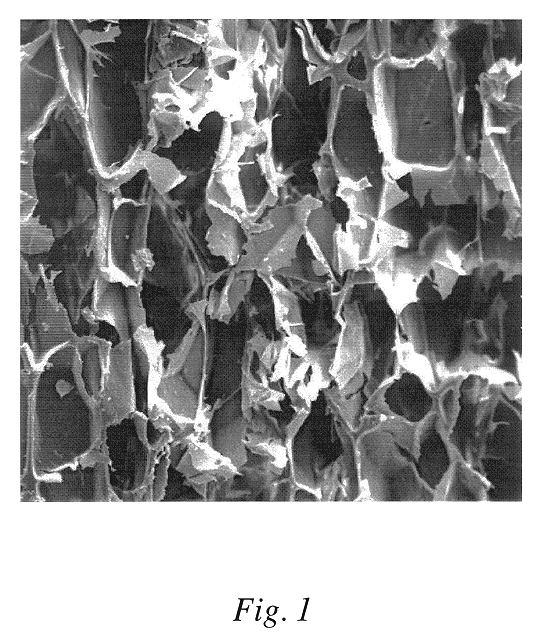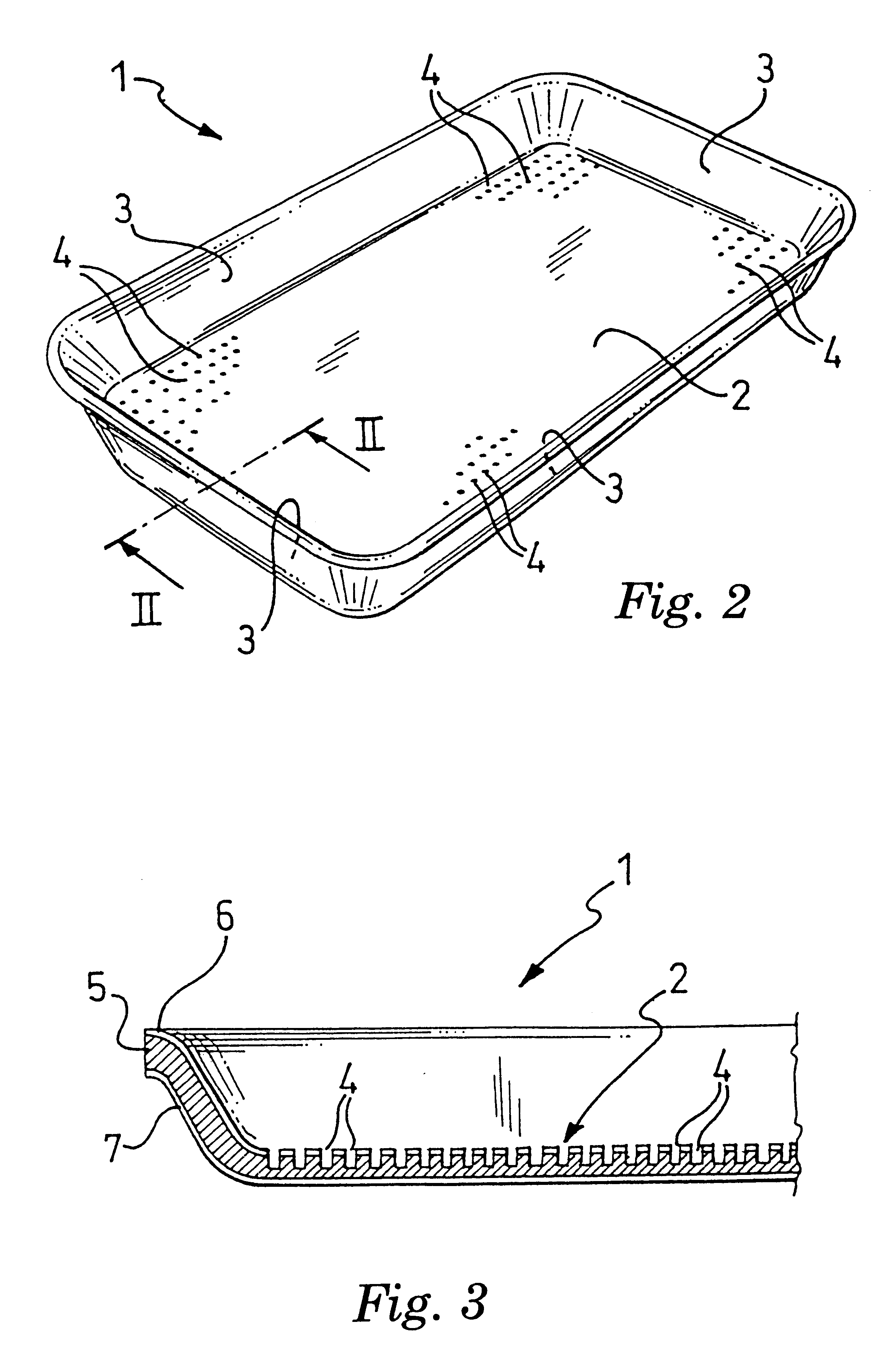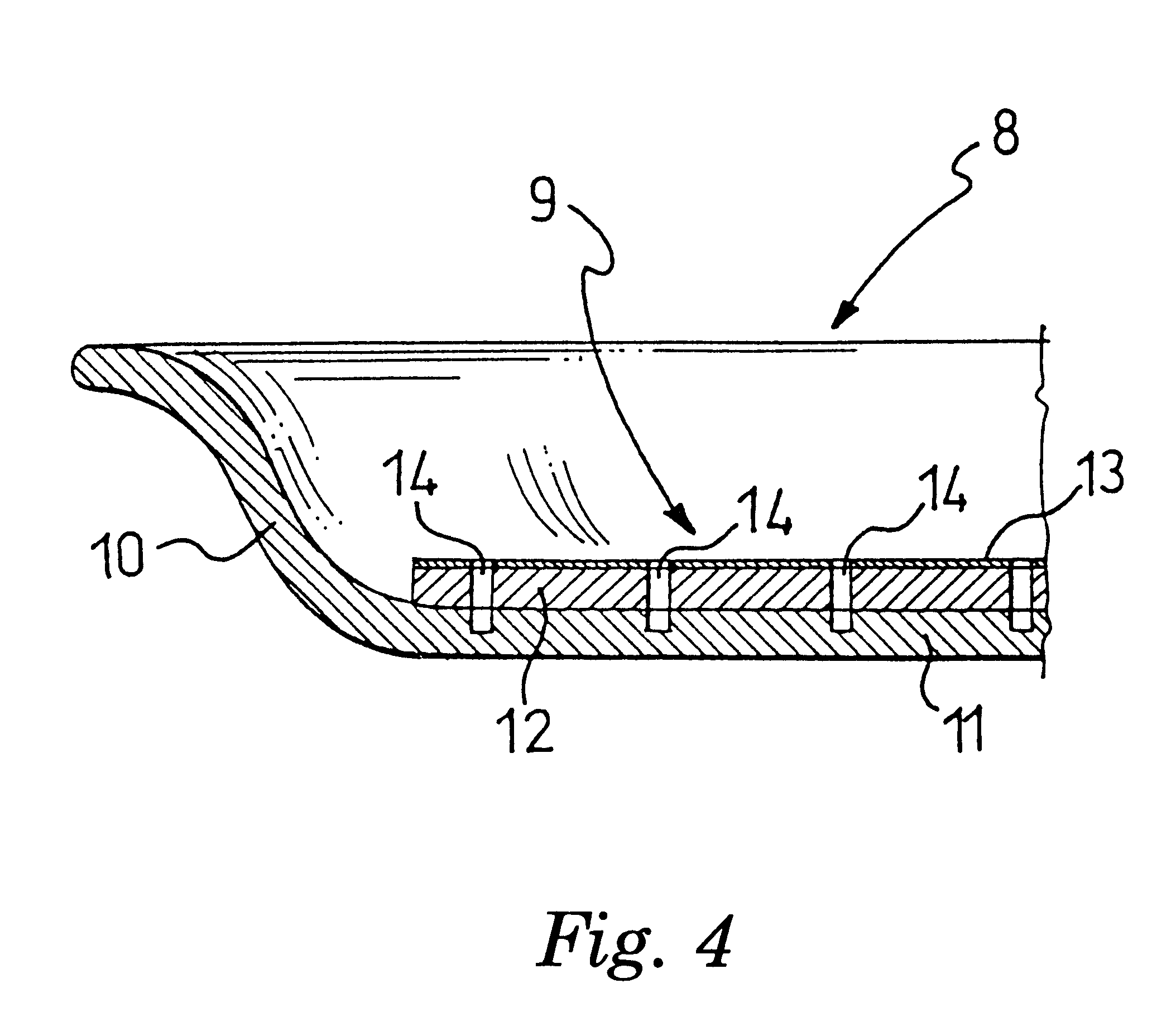Method for the production of substantially open-cell polystyrene sheet
a polystyrene sheet, substantially open-cell technology, applied in the direction of packaging, containers preventing decay, containers, etc., can solve the problems of large holes, low or no chance of recycling, and large production cost of these trays, so as to reduce the density, save energy, and increase the volume of liquid
- Summary
- Abstract
- Description
- Claims
- Application Information
AI Technical Summary
Benefits of technology
Problems solved by technology
Method used
Image
Examples
example 1
90 kg of VESTYPOR 10N.RTM. expandable polystyrene from HULS, containing 6.4% by weight of pentane, was mixed with 4.0 kg of HOSTASTAT SYSTEM E 3904.RTM. and 6.0 kg of talc powder and supplied into an extruder with two screws, with a cylinder diameter of 122 mm, a length / diameter ratio (L / D) of 20, and a flow rate of 125 kg / h.
The mixture of the aforementioned components, which had already been melted and amalgamated in the first portion of the extruder, was extruded (head pressure 40 bars) through a circular die having a 1 mm opening.
The temperature profile in the various regions of the extruder, from the supply region towards the extrusion head, was as follows:
T1 194.degree. C. T2 199.degree. C. T3 213.degree. C. T4 146.degree. C. T5 149.degree. C. T6 149.degree. C. T7 151.degree. C. T8 149.degree. C. T9 144.degree. C. T10.sup. 139.degree. C.
The temperature of the molten mixture in the region immediately preceding the output of the extruder was 146.degree. C.
The cylindrical, tubular...
example 2
76.0 kg of EXTIR A 7000.RTM. expandable polystyrene from ENICHEM, containing 6% by weight of pentane, was mixed with 14.0 kg of EDISTIR SR 550.RTM. shock-resistant polystyrene, 4.0 kg of HOSTASTAT SYSTEM 3904.RTM. and 6.0 kg of talc and supplied into an extruder with two screws with a cylinder diameter of 122 mm, a length / diameter ratio (L / D) of 20, and a flow-rate of 125 kg / h.
The mixture of the aforementioned components, which had already been melted and amalgamated in the first portion of the extruder was extruded (head pressure 50 bars) through a circular die having a 0.8 mm opening.
The temperature profile in the various regions of the extruder, from the supply region towards the extrusion head, were as follows:
T1 195.degree. C. T2 193.degree. C. T3 212.degree. C. T4 140.degree. C. T5 145.degree. C. T6 144.degree. C. T7 143.degree. C. T8 145.degree. C. T9 145.degree. C. T10.sup. 139.degree. C.
The temperature of the molten mixture in the region immediately preceding the output of ...
example 3
78.0 kg of EXTIR A 7000 expandable polystyrene from ENICHEM, containing 6.5% by weight of pentane, was mixed with 13.0 kg of VESTYRON 314 crystal polystyrene from HULS, 4.0 kg of HOSTASTAT SYSTEM E 3904.RTM. and 5.0 kg of talc and supplied into an extruder with two screws, with a cylinder diameter of 122 mm, a length / diameter ratio (L / D) of 20, and a flow-rate of 125 kg / h.
The mixture of the aforementioned components, which had already been melted and amalgamated in the first portion of the extruder was extruded (head pressure 40 bars) through a circular die having a 0.8 mm opening.
The temperature profile in the various regions of the extruder, from the supply region towards the extrusion head, was as follows:
T1 200.degree. C. T2 206.degree. C. T3 212.degree. C. T4 149.degree. C. T5 151.degree. C. T6 150.degree. C. T7 152.degree. C. T8 145.degree. C. T9 144.degree. C. T10.sup. 140.degree. C.
The temperature of the molten mixture in the region immediately preceding the output of the ex...
PUM
| Property | Measurement | Unit |
|---|---|---|
| temperature | aaaaa | aaaaa |
| density | aaaaa | aaaaa |
| temperature | aaaaa | aaaaa |
Abstract
Description
Claims
Application Information
 Login to View More
Login to View More - R&D
- Intellectual Property
- Life Sciences
- Materials
- Tech Scout
- Unparalleled Data Quality
- Higher Quality Content
- 60% Fewer Hallucinations
Browse by: Latest US Patents, China's latest patents, Technical Efficacy Thesaurus, Application Domain, Technology Topic, Popular Technical Reports.
© 2025 PatSnap. All rights reserved.Legal|Privacy policy|Modern Slavery Act Transparency Statement|Sitemap|About US| Contact US: help@patsnap.com



